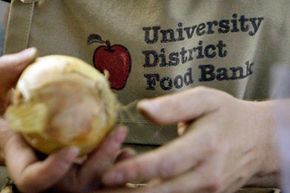When resources are stretched tight, making ends meet can be a challenge. Families in the United States are being squeezed by high prices on one side and dwindling jobs, disappearing benefits and a shrinking dollar on the other. More and more are turning to a national network of food banks and free food outlets for help.
There are more than 200 food banks in the United States that serve more than 63,000 agencies providing meals or food to the public on a regular basis. The U.S. Department of Agriculture (USDA) estimates that these organizations distribute more than 2.5 billion pounds of food to the hungry every year. If the economy continues to falter, even that may not be enough.
Advertisement
Hunger in the United States is at its highest point since 1994 when the USDA started keeping detailed records. Figures released by the U.S. Census Bureau for 2009 indicate that 44 million people, or one in seven, are living at or below the poverty line. This is defined as having a pretax income of $10,830 or less for a single person and $22,050 for a family of four.
On the next pages, we'll take a look at how food banks operate and where they get the food they help bring to American tables. We'll also discuss ways you can help to make mealtime a certainty for children and families who need a helping hand.
Advertisement


